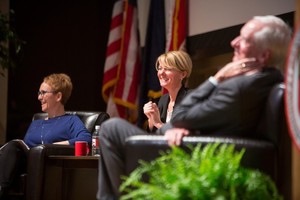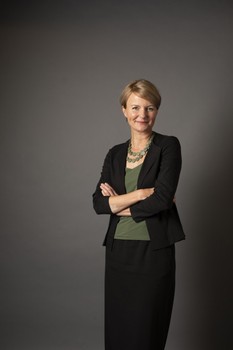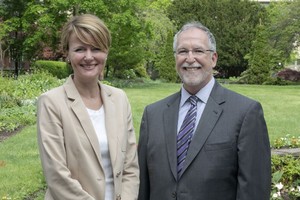CLASSE NEWS | 5 Sep 2018
 What have you found most surprising about your role in this past year?
The work I do is surprisingly creative and poses its own questions and challenges: What does it take to help faculty innovate? How can we best bring about change? There is a lot of evidence and research about these topics, but how do we apply it specifically at Cornell? It takes ongoing experimentation as well as reliance on data. In that way it is also surprisingly similar to my work as an experimental physicist.
Another surprise was that our students are great advocates of innovation. They are full of ideas and can give us valuable information about what works and doesn't. I have learned over the years that most students now expect to actively participate in lectures rather than passively absorb information. They expect to use modern technology. They feel an urgency to succeed and to tackle the world's problems. They want to challenge and be challenged. I believe that providing them with that opportunity is part of Cornell's mission.
The original version of this article appeared on The Cornell Chronicle.
What have you found most surprising about your role in this past year?
The work I do is surprisingly creative and poses its own questions and challenges: What does it take to help faculty innovate? How can we best bring about change? There is a lot of evidence and research about these topics, but how do we apply it specifically at Cornell? It takes ongoing experimentation as well as reliance on data. In that way it is also surprisingly similar to my work as an experimental physicist.
Another surprise was that our students are great advocates of innovation. They are full of ideas and can give us valuable information about what works and doesn't. I have learned over the years that most students now expect to actively participate in lectures rather than passively absorb information. They expect to use modern technology. They feel an urgency to succeed and to tackle the world's problems. They want to challenge and be challenged. I believe that providing them with that opportunity is part of Cornell's mission.
The original version of this article appeared on The Cornell Chronicle.
Thom-Levy channels innovation to benefit faculty and students
*Julia Thom-Levy*, professor in physics and vice provost for academic innovation, oversees Cornell's Center for Teaching Innovation (CTI) and the Office of Undergraduate Research. Her position was created a year ago, and CTI was formed by merging the former Center for Teaching Excellence with the Academic Technologies unit in Cornell Information Technologies. How does your position fulfill President Martha E. Pollack's priority to enhance the university's academic distinction? President Pollack's vision of "educational verve" has been inspirational. She introduced a spirit of experimentation and openness, and energized the teaching community to embrace new methods, technologies and ideas. This goes hand in hand with Provost Michael Kotlikoff's commitments in the area of academic innovation. In my new role I am charged with opening up new opportunities and creating better support structures that allow our very busy teaching community to innovate and to continue to create vibrant and challenging opportunities for learning. What are some of those innovations and opportunities, and what changes are laying the groundwork for additional progress? The creation of the Center for Teaching Innovation was an essential first step. The center brings together Cornell staff who are pedagogy experts with data experts, assessment specialists and technological support for teaching. It's an extremely talented and dedicated group, with an experienced director - Mathew Ouellett. He has been a terrific leader and brings deep expertise in the area of inclusive classroom teaching and pedagogy. We're still discovering how powerful this center and this combination of experts can be. Most faculty are super busy with their research and teaching, and even if they want to innovate and embrace new techniques, they may not have the time to read all the literature and keep up with the latest research about teaching and learning. So we have to be flexible; we have to provide fast, expert help, for example through online resources, consultations and short workshops. The center also is an important support structure for new initiatives. For example, we are working on ways to help our faculty engage an increasingly diverse student body, how to connect across differences, and integrate meaningful discussions in the classroom and the curriculum. Another example: the provost's Gateway Initiative aims to improve specific courses that serve large numbers of students from all over the university and are gateways to majors or other curricular pathways. Grants are another vehicle for innovation. Modern technology has created a huge opportunity for faculty to explore new modes of teaching, such as online and blended teaching, global learning and interdisciplinary teaching. We are inviting the Cornell teaching community to propose projects that explore emerging technologies and approaches. The center has already received lots of very exciting proposals, and we will start awarding project funds and support staff help to make these ideas a reality in the classroom. Finally, we are transitioning our course management system. This is a digital space that helps faculty create, administer and teach their courses. We are moving from Blackboard to Canvas, a younger company that was designed from the very beginning to be easy to learn and use. That matters for both faculty and students. It is also a tool that helps encourage innovations and improvements. This will set the stage for more flexible use of technology and better course design. What does the shift away from traditional lectures to active learning and other pedagogical methods mean for the student experience? In a nutshell, the shift means better learning outcomes, and happier and more engaged students. There is a substantial and growing body of research that shows students need to be actively engaged to learn, with much more direct interaction among students, and between students and instructors, than in the traditional lecture-based format. This goes far beyond simply adding clicker questions to a traditional lecture. The data we are starting to see from redesigned classrooms within and outside of Cornell are extremely convincing. They strongly indicate improved learning outcomes for students; lower rates of students withdrawing, quitting or failing in redesigned courses; and higher rates of persistence in particular curricular pathways. Such pedagogies can make use of modern technologies like online active learning and learning analytics. Alumni and parents find these trends intriguing, but they also have lots of questions. For example, is there no place for a great traditional lecture? Is active learning the right pedagogy for shy and introverted students? Is the cost and range of supported educational technologies reasonable? I had many of the same questions and concerns when I started using these methods. Relying less on a lecture-heavy format is not about catering to shorter attention spans. Lectures can be a really important element, as long as students are also really engaged and active. I think that active learning techniques also train students in what is needed today: for example, to talk across difference, to work in teams. If I think back to my own experience as a student: I really loved an excellent lecture, but I learned by working through problems and by discussing them with my fellow students. Can you share an example of a new technique or technology that is producing meaningful results? One transformative experience happened in my own department, physics, in the College of Arts and Sciences. Before I took on my current position I participated in the Active Learning Initiative in the college, which was funded by gifts from Alex and Laura Hanson [both Class of '87] beginning in 2013 and unfolded under the leadership of Dean Gretchen Ritter '83 and Peter Lepage as director. We transformed the three-course introductory physics sequence taken by all engineering students at Cornell using active learning methods and a variety of classroom technology, and the results exceeded all expectations. I still remember watching my freshman course of 400 students become alive with discussion on the first day of lecture, which in previous years had been completely quiet. Across all three courses and instructors, there was a fourfold reduction in the number of students with failing or marginal grades. Student evaluations from these courses were also significantly higher. The success in these courses has inspired other faculty in our department to experiment with active learning. The number of physics faculty using active learning has more than doubled from the original team of six. Before I participated in this experiment I had not been particularly aware of advances in educational research, but seeing the improvement for my students was transformative. It was also a lot more fun to teach that way and completely changed my perspective and motivation to learn more and try more, and to help work on institutional change. With Alex and Laura Hanson's continued support, we have just expanded the Active Learning Initiative universitywide and have also hired faculty in the area of discipline-based education research. These are two of the most exciting recent developments at Cornell, and I believe that it will put us at the cutting edge of pedagogy innovation. How have you measured your impact, and CTI's, in this past year? My position and CTI are just a year old, so we are still in the building phase and don't yet have a lot of data. It takes time to implement meaningful new support structures and to assess their effectiveness. We do know that lots of departments and faculty members are interested and contact us for information, participate in workshops and apply for the grant opportunities we have so far. One of the ways we will measure success in the future is by the number of instructors and departments participating in innovation projects and other opportunities, and how that changes the student experience. You also oversee the Office of Undergraduate Research. How does that fit into your academic innovation efforts? I'm very excited about this part of my responsibility and was eager to add it to my portfolio. I've worked with dozens of undergraduate students in my own lab and believe that involving students directly in research is one of the most valuable teaching practices we have available at Cornell. In a way, it's the ultimate active learning opportunity for our students. It's often a "real-world" experience and places students in a vibrant community of scholars and researchers. Sixty-five percent of our graduating seniors report having participated in research activities, and my goal is to improve access to this opportunity.
Thom-Levy, center, with professor Tracy McNulty, left, and President Emeritus Hunter Rawlings III during the 2016 Trustee Council Annual Meeting Weekend.


